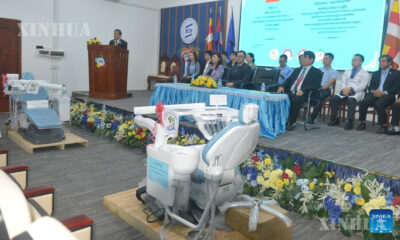Agriculture
တရုတ်နိုင်ငံ၏ နွေရာသီ လယ်ယာသီးနှံရိတ်သိမ်းခြင်းနှင့် စားနပ်ရိက္ခာဖူလုံရေး
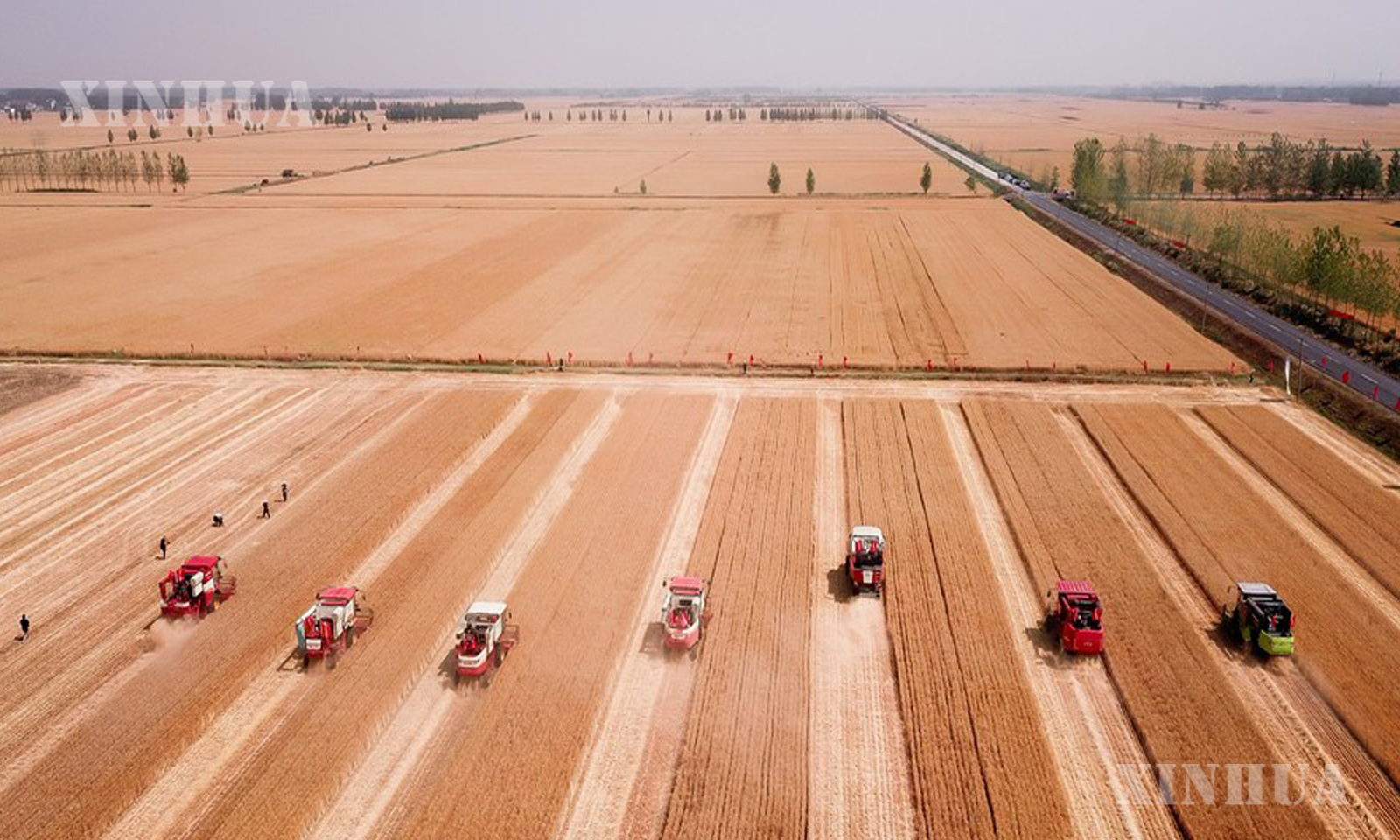
ကျိနန်၊ ဇွန် ၉ ရက်(ဆင်ဟွာ)
လက်ရှိ တရုတ်နိုင်ငံ၏ ကျယ်ပြန့်များပြားလှသော လယ်ယာမြေများတွင် လယ်ယာသုံးစက်ပစ္စည်း ၁၆.၅ သန်းခန့်သည် လယ်ယာတောင်သူနှင့်နည်းပညာသမား ၃ သန်းကျော်ခန့်နှင့်အတူ နွေရာသီရိတ်သိမ်းကာလလုပ်ငန်းစဉ်များတွင် ပါဝင်ဆောင်ရွက်လျက်ရှိသည်။
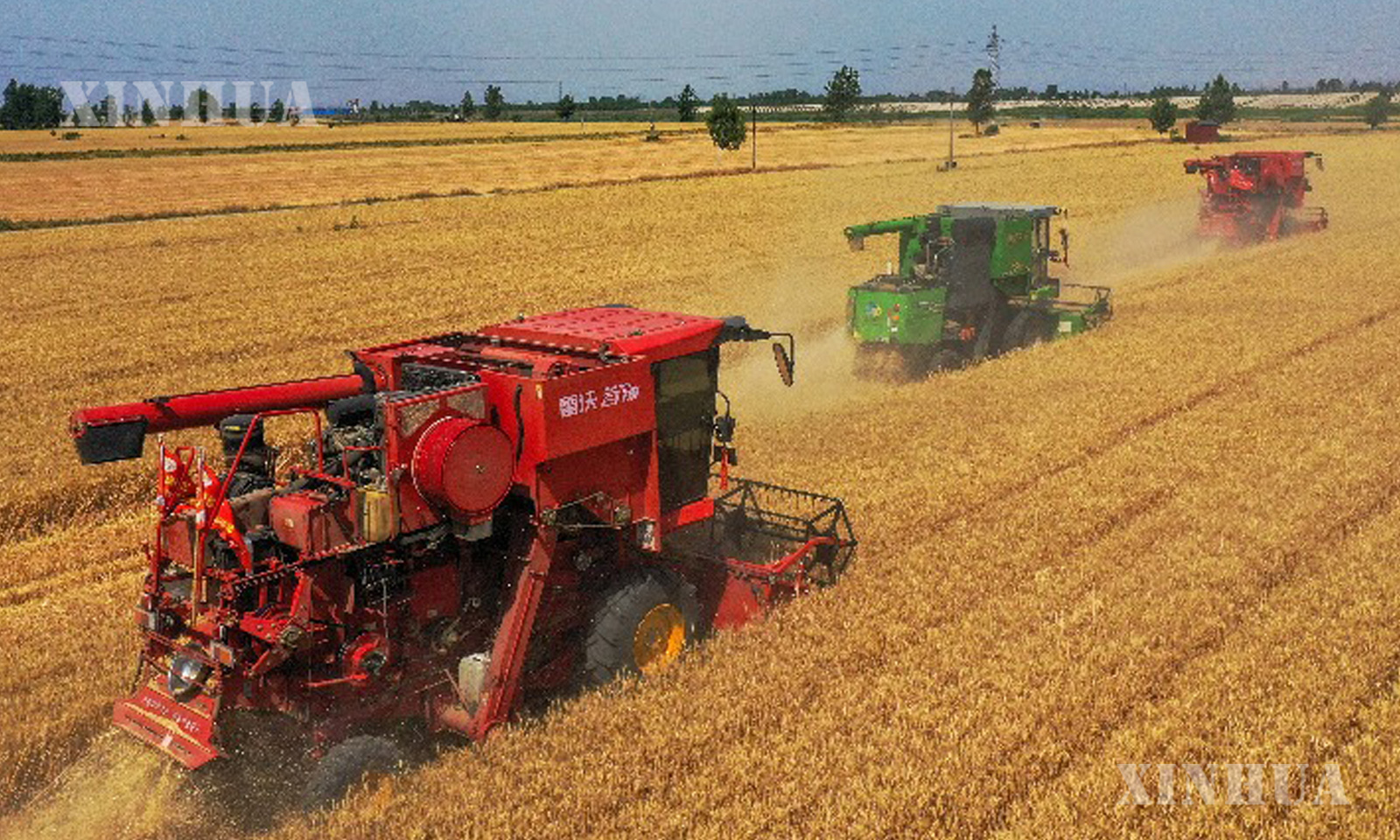
တရုတ်နိုင်ငံ မြောက်ပိုင်း ဟဲပေပြည်နယ် ရှင်ထိုင်မြို့ ဆန်းစီ မြို့နယ် ရှီးဆုန်းကျေးရွာ ဂျုံရိတ်သိမ်းမှုများအား ဇွန် ၈ ရက်က တွေ့ရစဉ်(ဆင်ဟွာ)
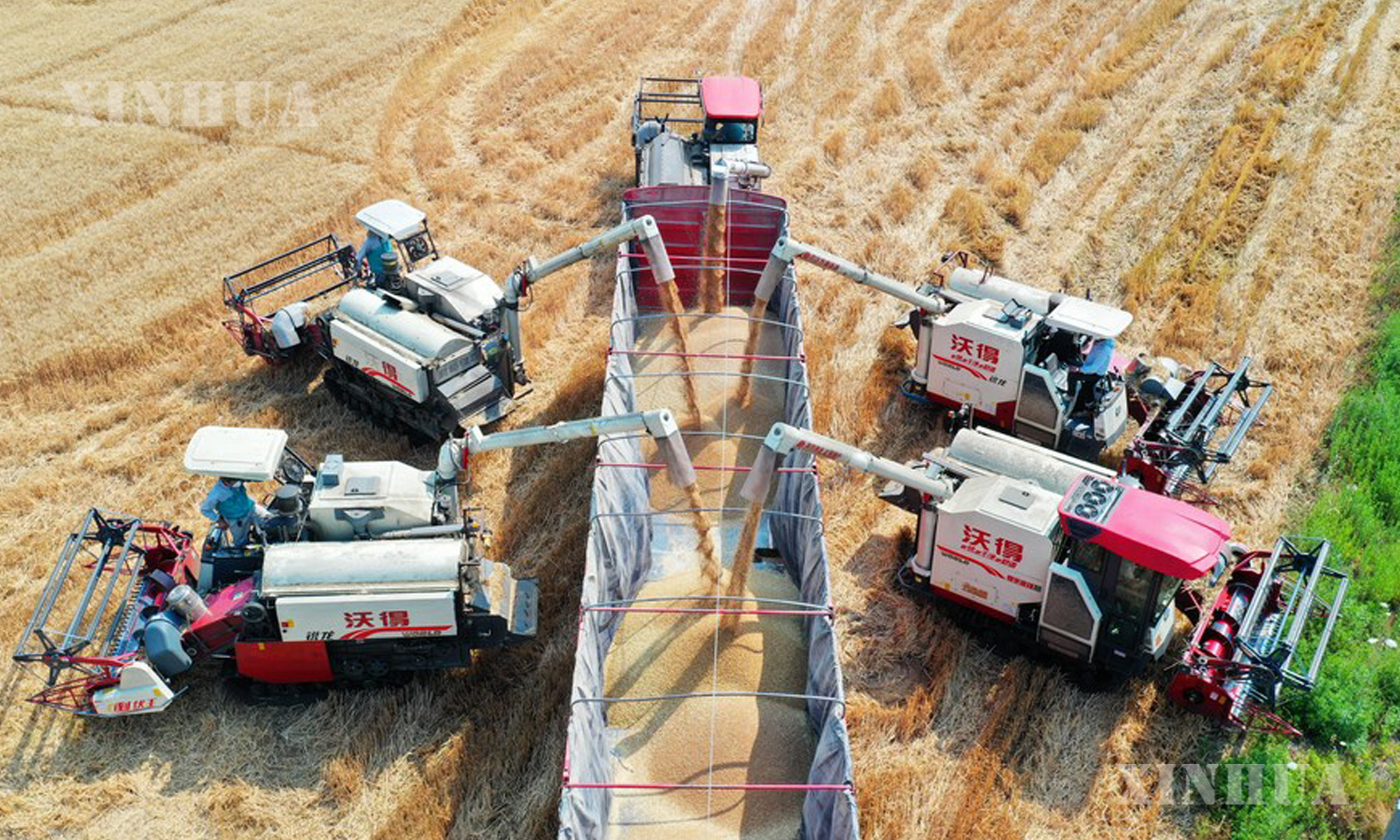
တရုတ်နိုင်ငံ အရှေ့ပိုင်း အန်းဟွေးပြည်နယ် ဟဲဖေမြို့ ရှောင်မြောင့်မြို့နယ် သွန်းချုံးကျေးရွားလေးတွင် ဂျုံရိတ်သိမ်းနေသည်ကို မေ ၂၅ ရက်က တွေ့ရစဉ်(ဆင်ဟွာ)
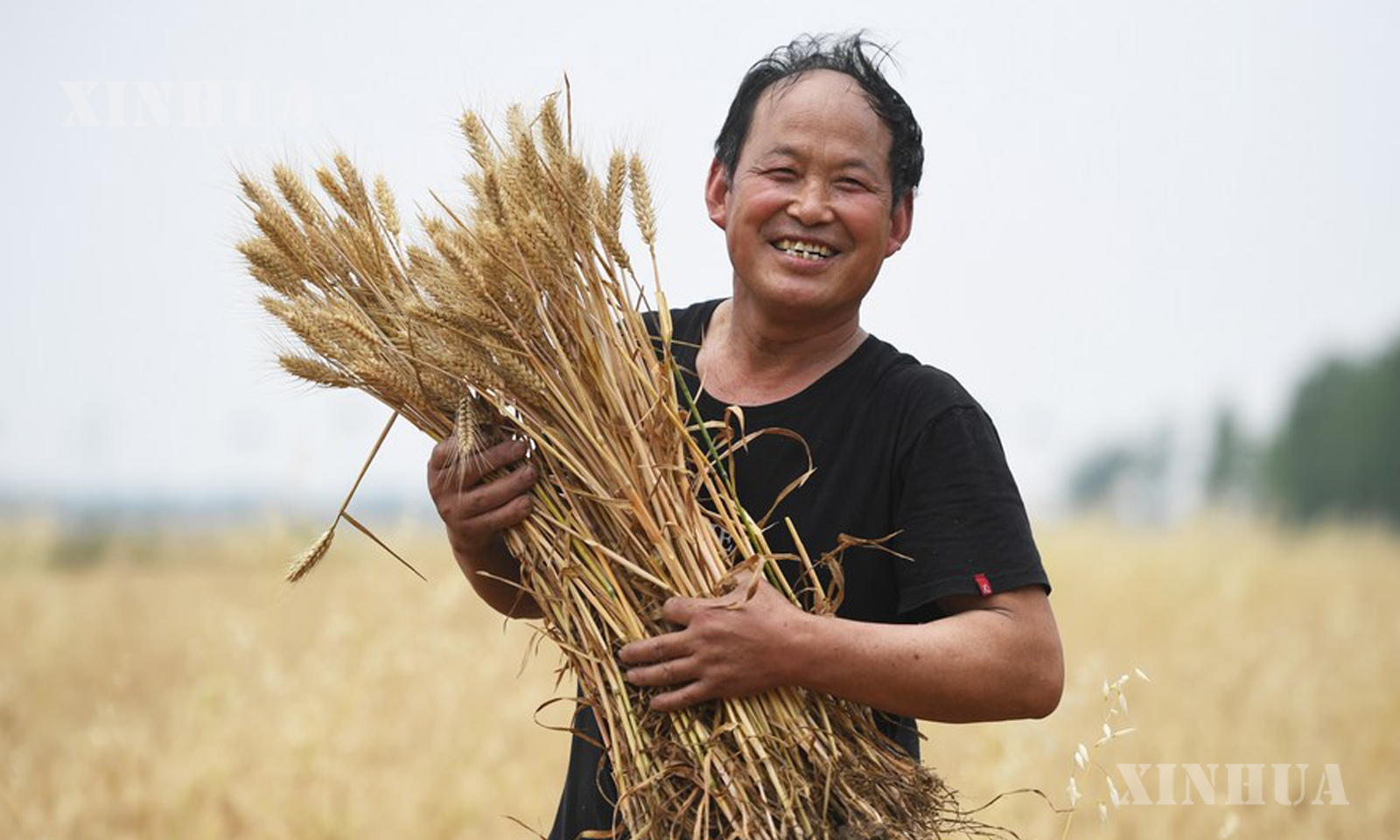
တရုတ်နိုင်ငံ အလယ်ပိုင်း ဟဲနန်ပြည်နယ် နန်ရန်မြို့ ထန်ဟဲခရိုင် ဟူရန်မြို့နယ်လေးတွင် အသစ်ရိတ်သိမ်းသော ဂျုံများကို လယ်သမားတစ်ဦးက ပြသနေသည်ကို မေ ၂၂ ရက်က တွေ့ရစဉ်(ဆင်ဟွာ)
ဇွန် ၆ ရက်(တနင်္လာနေ့)အထိ တရုတ်နိုင်ငံတွင် ဆောင်းရာသီဂျုံသီးနှံ လယ်ယာမြေ မို ၁၆၇ သန်း(ဟက်တာ ၁၁.၁၃ သန်းခန့်)ရိတ်သိမ်းပြီးဖြစ်ရာ ၎င်းမှာ ဆောင်းရာသီဂျုံးသီးနှံ၏ ၅၅ ရာခိုင်နှုန်းခန့်ရှိကြောင်း တရုတ်နိုင်ငံ စိုက်ပျိုးရေးနှင့်ကျေးလက်ရေးရာဝန်ကြီးဌာနမှ သိရသည်။
တရုတ်နိုင်ငံ အနောက်တောင်ပိုင်း စီချွမ်းပြည်နယ်နှင့် အလယ်ပိုင်း ဟူပေပြည်နယ်ရှိ ဂျုံသီးနှံရိတ်သိမ်းမှုများ ပြီးဆုံးတော့မည် ဖြစ်သော်လည်း ဆန်ရှီး၊ ဆန်းတုန်း၊ ဆန်းရှီးနှင့်ဟဲပေ ပြည်နယ်များတွင်မူ ရိတ်သိမ်းရေးလုပ်ငန်းများ မကြာမီ ဘက်စုံစတင်တော့မည် ဖြစ်သည်။
တရုတ်နိုင်ငံ၏ နွေရာသီ သီးနှံရိတ်သိမ်းမှုသည် ဆောင်းဂျုံနှင့် ဆီထွက်သီးနှံကို အဓိကအားထားခြင်း ဖြစ်သည်။ အစဉ်အလာအရ မေလ နှောင်းပိုင်းမှ ဇွန်လအတွင်း ရိတ်သိမ်းသည့်ပမာဏသည် တစ်နှစ်ပတ်လုံးပမာဏ၏ လေးပုံတစ်ပုံ ဖြစ်ရာ တရုတ်နိုင်ငံ စားနပ်ရိက္ခာဖူလုံရေးအတွက် အထူးအရေးကြီးကြောင်း သိရသည်။
ရိတ်သိမ်းချိန် လေလွင့်ဆုံးရှုံးမှု လျှော့ချခြင်း
ယခုနှစ် နွေရာသီ သီးနှံရိတ်သိမ်းရေးတွင် ရိတ်သိမ်းမှုလုပ်ငန်းစဉ်၌ လေလွင့်ဆုံးရှုံးမှုများ တတ်နိုင်သမျှလျှော့ချရေးမှာ အဓိကသော့ချက်ဖြစ်သည်။
တရုတ်နိုင်ငံ၏ ဒုတိယအများဆုံး ဂျုံထုတ်လုပ်ရာ နေရာဖြစ်သော ဆန်းတုန်းပြည်နယ်၌ ခရိုင်နှင့်မြို့အသီးသီးရှိ ဂျုံစိုက်ခင်း ဟက်တာ ၃၃,၀၀၀ ကျော်တွင် ပုံစံအသွယ်သွယ်ဖြင့် ရိတ်သိမ်းချိန်လေလွင့်ဆုံးရှုံးမှုမရှိရေး ဆောင်ရွက်နေသည်။
ရိတ်သိမ်းချိန် ဆုံးရှုံးလေလွင့်မှုများကို ပျမ်းမျှ ၂ ရာခိုင်နှုန်းအောက်လျှော့ချရန်အတွက် ဆန်းတုန်းပြည်နယ်တွင် လယ်သမား၊စိုက်ပျိုးရေးနည်းပညာရှင် ၂၈၀,၀၀၀ ကျော်က စိုက်ပျိုးရေးသုံး စက်ပစ္စည်း ၁. ၅ သန်းကျော်နှင့်အတူ လုပ်ငန်းစဉ်တွင် ပါဝင် ကြိုးပမ်းဆောင်ရွက်လျက်ရှိသည်။
ထိုရည်မှန်းချက်ကို ရောက်ရှိခြင်းအားဖြင့် ပြည်နယ်တစ်ခုလုံးအတိုင်းအတာအရ ရိတ်သိမ်းရေးလုပ်ငန်းစဉ်တွင် ဂျုံသီးနှံ သန်းပေါင်း ၃၀၀ ကျော်၏ လေလွင့်မှုကို ကာကွယ်နိုင်မည် ဖြစ်ကြောင်း ဒေသစိုက်ပျိုးရေးရုံး၏ ပြောကြားချက်များအရ သိရသည်။
တရုတ်နိုင်ငံ မြောက်ပိုင်း ဆန်းရှီး ယွင့်ချိန်မြို့၏ လယ်သမား တုန်းဟွေးလုံက ယခုရက်ပိုင်းတွင် ပျော်ရွှင်ရကြောင်း ဆိုသည်။
“ဂျုံစိုက်ပျိုးချိန်က နောက်ကျပေမယ့် နောက်ပိုင်း စီမံခန့်ခွဲမှုကောင်းတာကြောင့် ပြီးခဲ့တဲ့နှစ်ထက် အထွက်နှုန်းတိုးလိမ့်မယ်လို့ ခန့်မှန်းရတယ်”ဟု ဂျုံစိုက်ခင်း ၈ ဟက်တာ စိုက်ပျိုးထားသူ တုန်းဟွေးလုံက ဆိုသည်။
ပြီးခဲ့သည့်နှစ် ဆောင်းဦးရာသီတွင် ရေကြီးရေလျှံဖြစ်ပွားမှုကြောင့် ဟဲနန်၊ ဆန်းတုန်းနှင့် ဆန်းရှီးပြည်နယ်အပါအဝင် တရုတ်နိုင်ငံ၏ နွေရာသီ စားနပ်ရိက္ခာထုတ်လုပ်ရေး အဓိကနေရာများတွင် ဟက်တာ သန်းပေါင်း ၇.၃ ကျော်၌ ဂျုံစိုက်ပျိုးချိန် နှောင့်နှေးခဲ့သည်။
ထို့ကြောင့် နွေရာသီစားနပ်ရိက္ခာထုတ်လုပ်ရေးအာမခံမှုရှိစေရန် တရုတ်ယွမ်ငွေ ၆ ဘီလီယံ ကျော်(ကန်ဒေါ်လာ သန်း ၉၀၀ ခန့်) အသုံးပြုပြီး စိုက်ပျိုးချိန်နှောင့်နှေးမှုကြောင့် ဖြစ်ပေါ်လာသည့် အကျိုးဆက်များကို ကုစားရန်နှင် လယ်သမားများကို ကူညီဆောင်ရွက်ပေးရန်အတွက် ကျွမ်းကျင်ပညာရှင်နှင့်နည်းပညာရှင်များကို ကျေးရွာများသို့ စေလွှတ်ခဲ့သည်။
“ကျွန်တော်တို့က မျိုးစေ့ရွေးချယ်မှု၊ မျိုးကြဲစိုက်မှုပမာဏ၊ မြေဩဇာကျွေးတဲ့ပမာဏတွေကို ပြန်လည်ချိန်ညှိပေးခဲ့တယ်။ ပြီးတော့ ဒေသခံလယ်သမားတွေနဲ့ ကိုယ်တိုင်တွေ့ဆုံပြီး လယ်ယာစိုက်ပျိုးရေးလမ်းညွှန်မှုတွေ ပေးခဲ့ပါတယ်”ဟု ယွင့်ချိန်မြို့ ယန်ဟူခရိုင် စိုက်ပျိုးရေးပညာရှင် လွီဖန်းက ဆိုသည်။
သိပ္ပံနည်းပညာက ဆောင်ကြဉ်းပေးသည့် ပြောင်းလဲမှု
သိပ္ပံနှင့်နည်းပညာ တိုးတက်လာမှုက တရုတ်နိုင်ငံ၏ စားနပ်ရိက္ခာထုတ်လုပ်ရေးစွမ်းရည်ကို တိုးမြှင့်စေသည်။
ယခုအခါ စမတ်စိုက်ပျိုးရေးနည်းပညာ၊ ဒရုန်းနှင့် ထွက်နှုန်းကောင်းသီးနှံအမျိုးအစားများကို တွင်ကျယ်စွာအသုံးပြုလာခြင်းကြောင့် မိရိုးဖလာစိုက်ပျိုးနည်းစနစ်များက အကြီးအကျယ်ပြောင်းလဲလာသည်။
အဆိုပါ အကျိုးကျေးဇူးများကြောင့် ၂၀၂၁ ခုနှစ်တွင် တရုတ်နိုင်ငံ၏ တစ်ဦးချင်း ပျမ်းမျှ စားနပ်ရိက္ခာပိုင်ဆိုင်မှုမှာ ကီလိုဂရမ် ၄၇၀ ကျော်ရှိခဲ့ရာ ၎င်းမှာ နိုင်ငံတကာ သတ်မှတ်ထားသော စားနပ်ရိက္ခာဖူလုံးရေး အခြေခံမျဉ်း ကီလိုဂရမ် ၄၀၀ ကို ကျော်လွန်ခဲ့သည်။
ယခုနှစ်တွင်မူ ဂျုံသီးနှံအရည်အသွေးနှင့်ဖူလုံရေးကာကွယ်နိုင်ရန်အတွက်ဆန်းတုန်းပြည်နယ် ကျို့ဖိန်မြို့ အဆင့်မြင့်လယ်ယာများ၌ အဖျက်ပိုး စောင့်ကြည့်ရေး အသိဉာဏ်ရှိစခန်းများ၊ နေရောင်ခြည်သုံး ပိုးသတ်မီးချောင်းများ ၊ စမတ်မိုးလေဝသဌာနများနှင့် ဒစ်ဂျစ်တယ် စောင့်ကြည့်ရေးဝန်ဆောင်မှု စနစ်များကို တည်ဆောက်တပ်ဆင်ပြီးဖြစ်သည်။
သိပ္ပံနည်းပညာ၊ ထုတ်လုပ်မှုနည်းလမ်းများ တိုးတက်လာခြင်းအပြင် တရုတ်နိုင်ငံက စားနပ်ရိက္ခာသိုလှောင်မှုကဏ္ဍတွင်လည်း သိသာထင်ရှားသည့် တိုးတက်မှုများရှိလာသလို ယခုနှစ်ပိုင်းများတွင် စားနပ်ရိက္ခာသိုလှောင်ရုံများကို အားကောင်းအောင် တည်ဆောက်ခဲ့သည်။
ဆန်းတုန်းရှိ Sinograin ဂျုံစပါးသိုလှောင်ရေးနေရာ၌ သိုလှောင်မှုအကောင်းဆုံး အခြေအနေဖြစ်စေရန်အတွက် high-definition ကင်မရာ ၄,၅၀၀နှင့် အာရုံခံအပူချိန်တိုင်းကိရိယာ ၂၈၀,၀၀၀ တပ်ဆင်ထားသည်။
စားနပ်ရိက္ခာအရည်အသွေးပြောင်းလဲမှုမရှိစေရန် ဗဟိုမှ လေထုအခြေအနေထိန်းညှိခြင်း၊ အသိဉာဏ်သုံး လေဝင်လေထွက်ရှိအောင် ဆောင်ရွက်ခြင်းနှင့် နိုက်ထရိုဂျင်သုံးအပူချိန်ထိန်းချုပ်ခြင်း စသည့်နည်းပညာများဖြင့် တစ်နှစ်ပတ်လုံး ၁၅ ဒီဂရီစင်တီဂရိတ်အောက် ထိန်းထားကြောင်း သိရသည်။
တရုတ်နိုင်ငံ၏ (၁၃)ကြိမ်မြောက် (၅)နှစ်တာ စီမံကိန်းဖြစ်သော ၂၀၁၆ ခုနှစ်မှ ၂၀၂၀ ပြည့်နှစ်တွင် ထုတ်လုပ်ပြီးနောက် လုပ်ငန်းစဉ်များ၌ နှစ်စဉ် လေလွင့်ဆုံးရှုံးမှု တန်ချိန်ပေါင်း ၁၃ သန်းခန့်ကို ကာကွယ်နိုင်ခဲ့ကြောင်း အချက်အလက်များက ဖော်ပြထားသည်။
“တရုတ်နိုင်ငံရဲ သိပ္ပံနည်းကျ ထိရောက်သော စီမံခန့်ခွဲမှုတွေက စားနပ်ရိက္ခာဖူလုံရေးအတွက် အာမခံချက် ဖြစ်စေခဲ့တယ်”တရုတ်နိုင်ငံ ဆန်းရှီးပြည်နယ် စိုက်ပျိုးရေးတက္ကသိုလ် ဒုတိယပါမောက္ခချုပ် ဝမ်ကျွင်းလျင်က ဆိုသည်။ (Xinhua)
………………………………………
(English Version)
Xinhua Headlines: China reaps bumper summer harvest securing food security
2022-06-08 14:51:15
JINAN, June 8 (Xinhua) — About 16.5 million pieces of agricultural machinery are currently roaring on the vast farmlands of China, with over 3 million farmers and technicians taking part in the country’s summer harvest.
By Monday, the country had finished reaping winter wheat on 167 million mu (about 11.13 million hectares) of farmland, accounting for around 55 percent of its total winter wheat, according to the Ministry of Agriculture and Rural Affairs.
Wheat harvest in southwest China’s Sichuan Province and central China’s Hubei Province has almost come to a close, while that in the provinces of Shaanxi, Shandong, Shanxi and Hebei will be in full swing soon.
China’s summer harvest focuses on reaping winter wheat and oilseed rape. Spanning from May to late June traditionally, the grain output in the period takes up about a quarter of the annual total, which is of great significance to China’s food security.
CUT LOSS
Minimizing the losses in the process of harvesting is one of the keywords of the summer harvest this year.
In east China’s Shandong Province, China’s second-largest wheat-producing area, a variety of loss-cutting activities have been carried out in each county and city with wheat plantation areas exceeding 33,000 hectares.
Meanwhile, more than 1.5 million sets of agricultural machinery and over 280,000 farmers and agricultural technicians are joining in the harvest in Shandong, striving to keep the average loss rate under 2 percent.
By reaching that goal, the whole province can save 300 million kg of wheat during the harvest, according to a local agricultural official.
Dong Huilong, a farmer in Yuncheng City, north China’s Shanxi Province, feels jubilant these days.
“Although wheat was sown late, the harvest is expected better than last year thanks to better management afterward,” said Dong, who grows over 8 hectares of wheat.
More than 7.3 million hectares of wheat were sown late in China’s major summer grain powerhouses, including the provinces of Henan, Shandong and Shanxi, due to floods last fall.
Therefore, more than 6 billion yuan (about 900 million U.S. dollars) have been pooled to ensure the production of summer grain. Experts and technicians have been sent to the villages to help farmers overcome the adverse impacts of the late sowing.
“We made some adjustments in seed selection, sowing volume, and the amount of fertilization. Furthermore, we provided face-to-face guidance to local farmers in the farmland,” said Lyu Fen, an agricultural expert in Yanhu District, Yuncheng.
TECH MAKES DIFFERENCE
The advancement of science and technology has boosted China’s grain production capacity.
Nowadays, the traditional production methods have undergone huge changes as smart agricultural technology, drones, and high-yielding varieties of crops have been widely used.
Benefiting from those aspects, China’s per capita share of grain exceeded 470 kg in 2021, higher than the internationally-recognized security baseline of 400 kg.
In the city of Zouping, Shandong, intelligent pest monitoring stations, solar insecticidal lamps, smart meteorological stations and digital monitoring and service systems have been installed in high-standard farms this year, in a bid to secure the quality and safety of wheat.
Besides scientific and advanced production methods, China has made substantial progress in the storage of grain and strengthened the construction of grain storage facilities in recent years.
The Sinograin grain storage site in Shandong is equipped with 4,500 high-definition cameras and 280,000 temperature sensors to ensure the stock is in the best condition.
Technologies including central air-conditioning, intelligent ventilation, and temperature control by nitrogen have been used there, to keep the average temperature below 15 degrees Celsius all year round, and prevent grain from going bad.
Data shows that during China’s 13th Five-Year Plan period (2016-2020), about 13 million tonnes of food had been saved annually during processes after production.
“China has used scientific and effective management means to ensure the food security,” said Wang Juanling, vice president of Shanxi Agricultural University. Enditem
1. Aerial photo taken on June 2, 2022 shows harvesters reaping wheat in the fields in Tancheng County of Linyi City, east China’s Shandong Province. (Xinhua/Guo Xulei)
2. Aerial photo taken on June 8, 2022 shows harvesters working in wheat fields in Xisong Village of Sansi Township, Xingtai City, north China’s Hebei Province. (Xinhua/Zhu Xudong)
3. Aerial photo taken on May 25, 2022 shows harvesters loading wheat onto a truck in Duanchong Village of Xiaomiao Township, Hefei City, east China’s Anhui Province. (Photo by Chen Sanhu/Xinhua)
4. Local farmer Bai Lucai shows newly-harvested wheat in Huyang Town of Tanghe County, Nanyang City, central China’s Henan Province, May 22, 2022. (Xinhua/Zhang Haoran)

